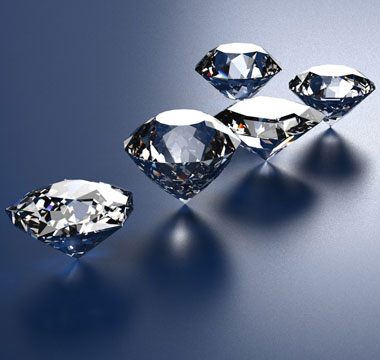
CUT
Of the four Cs, cut is perhaps the most important factor affecting a diamond’s overall quality and beauty. A diamond’s brightness, or its brilliance, is determined by how much light is reflected back to your eyes. Light enters the stone through the crown, which is the portion of the diamond above the girdle. The crown is made up of the table, which is the large flat facet on top of the diamond, and many crown facets. It then travels to the pavilion, or body, of the stone, where it is reflected from one side to the other and then back through the top and to an observer’s eye.
A well cut, well proportioned stone evenly reflects and refracts light within the stone, thereby producing an eye-catching, fiery spectrum of color. A poorly cut diamond, on the other hand, allows more light to pass through or “leak” from the sides of the stone, which results in a lifeless appearance with reduced sparkle.
The science behind diamond cutting is more or less an exercise in proportion. Changing the proportion of a diamond’s depth and width is done in order to maximize the stone’s brilliance. If the cut adheres to certain “ideal” proportions, the results can be spectacular. If poorly cut, the results can be so bad as to cause structural instability, which makes the stone susceptible to breaking. Because cut is so important, gemologists have developed grading methods to assist consumers in determining a diamond’s cut. In general, they are: Ideal, Excellent, Very Good, Good and Fair.
The ideal proportions shown below are known as the Tolkowsky Theoretical Brilliant cut. In 1919, Marcel Tolkowsky published a paper detailing ideal proportions for a round brilliant diamond. Modern cutters offer a wide range of opinions on the “ideal” cut, but Tolkowsky’s findings are mathematically indisputable and remain the basis for these modern ideal proportions.
COLOR
The measurement and comparison of diamond color ranges from colorless to slightly tinted. However, discerning the subtle differences between sequential color grades can be almost impossible with the naked eye. For this reason, a letter scale, such as the GIA professional color scale which ranges from D to Z, was created to assist in distinguishing a diamond’s color grade. Diamonds that are in the “D-F” range are considered colorless. These diamonds are rarer and more expensive. Diamonds in the “G-I” range appear completely white to most observers and for this reason can be a better value than colorless diamonds. Color grades beyond “J” exhibit a yellowish or brownish tint, which is increasingly discernable by the untrained eye as you approach the extreme end of the spectrum.
CARAT
A carat is a unit of measure for diamonds, where one carat equals 100 points, or 0.2 grams. This measurement is referred to as the carat weight and is used to determine a diamond’s size. Larger diamonds are more rare and therefore more highly valued. In addition, larger diamonds make it easier to see the effects of other key characteristics, such as cut and color. Depending on the significance of these other characteristics, diamonds of a similar size (carat weight) may differ dramatically in price.
CLARITY
Clarity is most often mistaken as being the factor that determines a diamond’s sparkle and brilliance. This is not true. Clarity describes the presence of imperfections both on and within a diamond. Most imperfections are microscopic flaws, or “inclusions,” formed inside the diamond during the formation process known as crystallization. Other flaws, however, appear on the surface of a diamond and may have appeared during the cutting process.
Essentially, the clarity grade describes the flawlessness of a diamond; the fewer the imperfections, the higher the clarity grading. Naturally, these imperfections have an impact on the value of a diamond, particularly those that may be viewed by the naked eye. In order to find and plot a stone’s flaws, gemologists use at least 10x loupe magnification when grading for clarity. Clarity grades range from Flawless, which are diamonds that reveal no imperfection even under 10x magnification, to Imperfect 3, which are stones with distinct blemishes visible to the naked eye. See below for a description of each clarity grading.
FL/IF – Flawless or Internally Flawless.
VVS1/VVS2 – Very, Very Small Inclusions. Requires 60X magnification to clearly see inclusions.
VS1/VS2 – Very Small Inclusions. Requires 30X magnification to clearly see inclusions. A good choice for those wishing to balance quality and affordability.
SI1/SI2 – Small Inclusions. Typically requires 10X magnification to clearly see inclusions. In larger carat weights, SI diamonds sometimes reveal their inclusions to the naked eye. The bigger the diamond, the more lenient the clarity grade as there is much more diamond.
SI3 – This is a new “non-sanctioned” clarity grade you will hear as you begin to shop for a diamond. It is a source of conflict within the industry as GIA does not sanction this designation. What you have is an inclusion that is visible face-up to the trained eye but it really doesn’t ruin the look of the diamond face-up.
I1 – Imperfect. Eye-Visible Inclusions. Often a popular choice for earrings or pendants, as these items are generally scrutinized less than diamond rings. Also a popular choice for those shopping on a budget.

